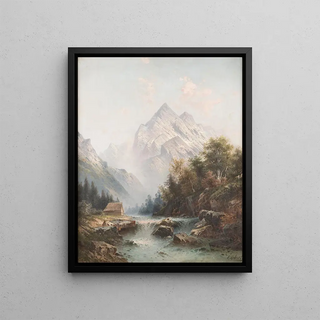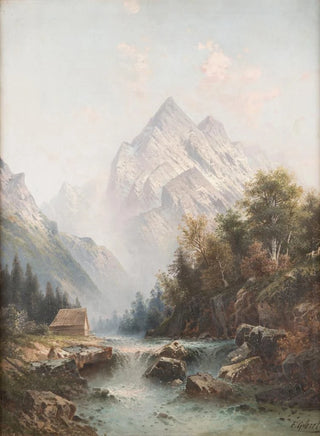Wild Stream in the Mountains - Karl Kaufmann Art print


View from behind

Frame (optional)
In the rich and captivating universe of landscape art, the artwork titled "Wild Stream in the Mountains" by Karl Kaufmann stands out for its visual intensity and immersive atmosphere. This canvas, which evokes the majesty of alpine landscapes, transports us to a world where nature reigns supreme. The shades of green and blue, intertwined with touches of light, create a colorful symphony that invites contemplation. The stream, gracefully winding, becomes the guiding thread of this piece, connecting natural elements in perfect harmony. Approaching this art print, the viewer is invited to feel the freshness of the water and the tranquility of the mountains, as if they were themselves at the heart of this idyllic scene.
Style and uniqueness of the work
Kaufmann's style is characterized by a realistic approach, but also by an impressionist sensitivity that manifests in the treatment of light and colors. Each brushstroke seems charged with emotion, giving life to a landscape where the movement of water and the rustling of foliage are palpable. The composition of "Wild Stream in the Mountains" is carefully orchestrated, with each element positioned to guide the viewer's gaze across the painting. The mountains, imposing and majestic, rise in the background, while the stream, in the foreground, offers an invitation to exploration. This work is not only a tribute to the beauty of nature but also a reflection on the relationship between man and his environment, a theme dear to many artists of the time.
The artist and his influence
Karl Kaufmann, a 19th-century painter, managed to mark his era with a unique vision of nature. Trained in the most prestigious art schools, he developed a style that combines precision and poetry. His works, often inspired by landscapes he traveled through, testify to meticulous observation and a deep admiration for natural wonders. Kaufmann was also influenced by his contemporaries, notably the impressionists, who paved the way for a new way of perceiving light and color. By integrating these elements into his work, he contributed

Matte finish

View from behind

Frame (optional)
In the rich and captivating universe of landscape art, the artwork titled "Wild Stream in the Mountains" by Karl Kaufmann stands out for its visual intensity and immersive atmosphere. This canvas, which evokes the majesty of alpine landscapes, transports us to a world where nature reigns supreme. The shades of green and blue, intertwined with touches of light, create a colorful symphony that invites contemplation. The stream, gracefully winding, becomes the guiding thread of this piece, connecting natural elements in perfect harmony. Approaching this art print, the viewer is invited to feel the freshness of the water and the tranquility of the mountains, as if they were themselves at the heart of this idyllic scene.
Style and uniqueness of the work
Kaufmann's style is characterized by a realistic approach, but also by an impressionist sensitivity that manifests in the treatment of light and colors. Each brushstroke seems charged with emotion, giving life to a landscape where the movement of water and the rustling of foliage are palpable. The composition of "Wild Stream in the Mountains" is carefully orchestrated, with each element positioned to guide the viewer's gaze across the painting. The mountains, imposing and majestic, rise in the background, while the stream, in the foreground, offers an invitation to exploration. This work is not only a tribute to the beauty of nature but also a reflection on the relationship between man and his environment, a theme dear to many artists of the time.
The artist and his influence
Karl Kaufmann, a 19th-century painter, managed to mark his era with a unique vision of nature. Trained in the most prestigious art schools, he developed a style that combines precision and poetry. His works, often inspired by landscapes he traveled through, testify to meticulous observation and a deep admiration for natural wonders. Kaufmann was also influenced by his contemporaries, notably the impressionists, who paved the way for a new way of perceiving light and color. By integrating these elements into his work, he contributed






